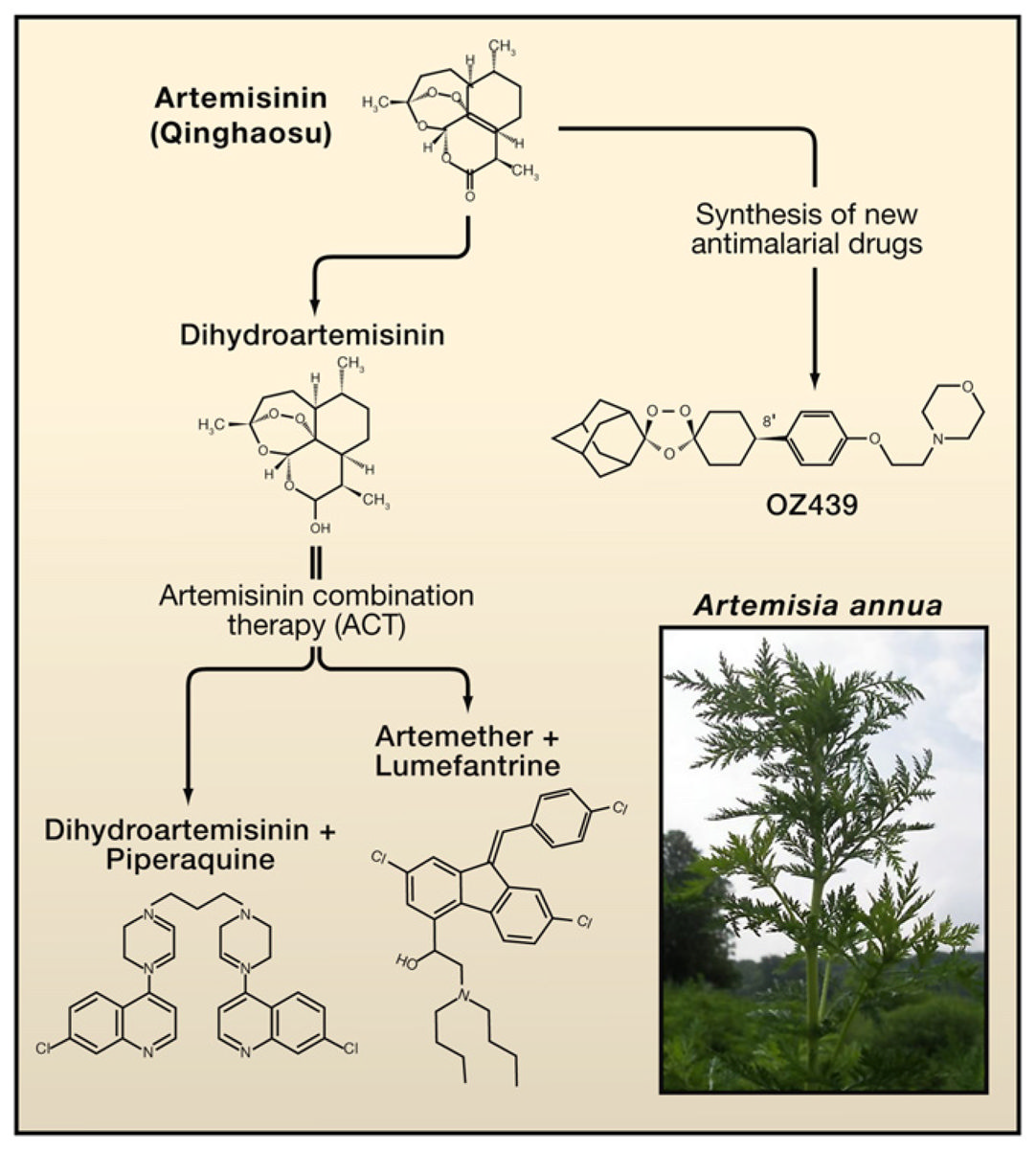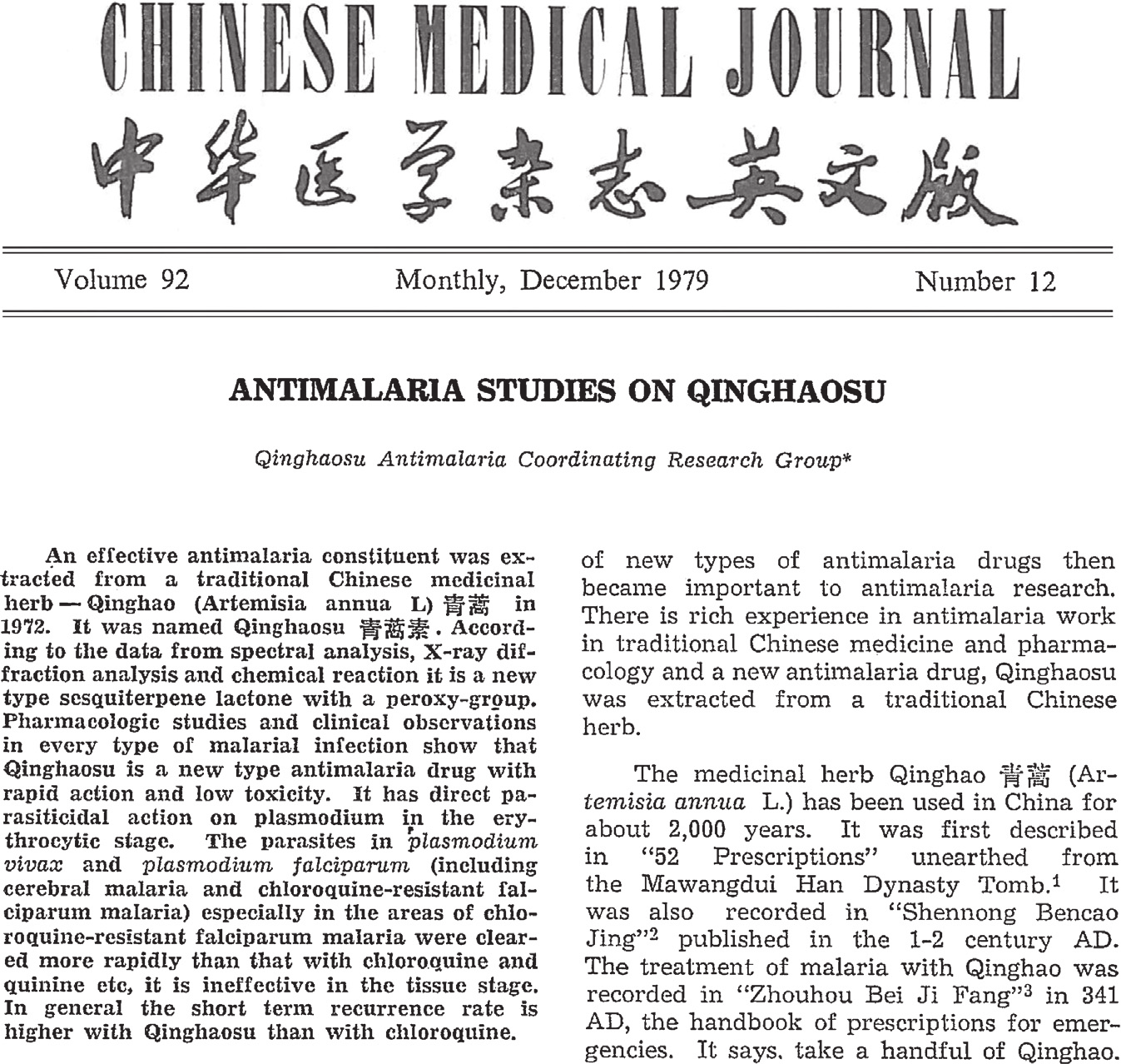The complexity of the medicinal plant Artemisia and the story of artemisinin

The story of artemisinin (BMRB entry bmse001249) originates in an opaque time of the Cultural Revolution in China. The Chinese government aided the North Vietnamese in their war with the United States in the nineteen sixties. During the war, malaria caused by drug-resistant protozoan parasites was a major problem on both sides of the swampy battlefield. In the US, the efforts to cure malaria resulted in the discovery of drug mefloquine. The North Vietnamese, however, lacked research infrastructure and turned to China for help. Under the instructions of Chairman Mao this led to a secret program called project 523, involving over 500 scientists in ~60 different laboratories and institutes. Although the project’s short-term goal was to produce antimalarial drugs that could immediately be used in the battlefield, there was also the long-term to search for new antimalarial drugs by screening synthetic chemicals - and by searching recipes and practices of traditional Chinese medicine.
Because this work was considered a military secret, no communication about the research to the outside world was allowed and publication in scientific journals was forbidden. For these reasons, no one outside of project 523 knew about the work. Yet within the project, information flowed freely and findings were presented at frequent joint meetings.
Without a publication record, who should be credited with the resulting discovery of anti malarial drug artemisinin? After deliberations, the major credit must go to Tu Youyou, who was a principal investigator at the Institute of Chinese Meteria Medica, China Academy of Chinese Medical Sciences. In 1969, Professor Tu led a team that was screening the literature and recipes of traditional Chinese medicine under project 523.
During their search, Tu Youyou and colleagues investigated more than 2,000 traditional Chinese recipes, such as "take one bunch of Qinghao, soak in two sheng of water, wring it out to obtain the juice and ingest it in its entirety" found in "The Handbook of Prescriptions for Emergency Treatments by Ge Hong" (283–343 CE) from the Jin Dynasty. Upon research she realized that traditional methods of boiling and extraction could damage the active ingredients. Once the milder experimental purification procedures were performed by her scientific group, the extract was found to still be toxic. Professor Tu further removed from the extract the portion that contained no antimalarial activity. The resulting extract with reduced toxicity and improved antimalarial activity was tested to achieve 100% parasite inhibition in animal trials, and Tu Youyou volunteered to be the first human test subject.
The work was presented internationally for the first time in 1981 in Beijing to a World Health Organization visiting study group on chemotherapy of malaria. In the year 2015, half of the Nobel Prize for Medicine or Physiology was awarded to Tu Youyou for her contribution to the discovery of artemisinin; the other half was awarded to the scientists for discoveries in fighting other parasitic diseases.

The original paper describing artemisinin’s X-ray crystal structure, pharmacology, and efficacy against non-severe and severe cerebral malaria still listed no specific authors, due to continuing secrecy.
Since the discovery of antimalarial drug Artemisinin (Qinghaosu) from Artemisia annua L., a plant used in traditional Chinese medicine, by Tu Youyou and colleagues, many related derivatives have been synthesized, including dihydroartemisinin that is more active than artemisinin. Today artemisinin derivatives, in combination with other antimalarial drugs, are the world's standard treatment for malaria [1].
The story of artemisinin continues with the explosive development of scientific fields connecting traditional medicines and cancer research.[2] It was concluded recently that artemisinin is effective against 55 cancer cell lines, with inhibitory effects against pancreatic cancer, osteosarcoma, lung cancer, colon, melanoma, breast, ovarian, prostate, central nervous system, lymphoma, leukemia and renal cancer cells. In addition, artemisinin compounds have been shown to have anti-angiogenic, anti-inflammatory, anti-metastasis, and growth inhibition effects.
Key metabolic differences between cancer cells and normal cells are exploited by application of artemisinin derivatives, . This enables a targeted non-toxic approach to cancer treatment. One such key metabolic difference is the higher iron (Fe) content of cancer cells. The molecular mechanism by which artemisinin compounds serve as effective anti-cancer agents, involves the endo-peroxide bridge of the artemisinin molecule.
The cancer cells crave iron and contain massive quantities of iron compared to normal cells. In addition, the transport mechanism for iron in cancer cells, called transferrin receptors are massively up-regulated. The more aggressive the tumor, the greater number of transferring receptors. This difference in iron content and iron transport is why artemisinin compounds kill cancer cells selectively while sparing normal cells. Artemisinin contains an endoperoxide bridge that can react with iron to form cytotoxic free radicals. These properties make artemisinin compounds attractive cancer chemotherapeutic drug candidates.
However, simple artemisinin analogs are less potent than traditional cancer chemotherapeutic agents and have short plasma half-lives. They would require high dosage and frequent administration to be effective for cancer treatment. More potent and target-selective artemisinin-based compounds are being developed. These include artemisinin dimers and trimers, artemisinin hybrid compounds, and tagging of artemisinin compounds to molecules involved in the intracellular iron-delivery mechanism. These produce significantly fewer side effects than traditional chemotherapeutic agents.

Cultural history of Artemisia plants is very rich and not confined to Oriental tradition, or malaria, cancer treatment, or medicinal use per se. The Bible, in the Book of Revelation refers to Wormwood as a star that plummets to Earth and carries with it bitterness that poisons a third of all of the earth's waters on The Day of the Lord. The word wormwood is the common name of Artemisia absinthium that has been long used to make bitter-tasting remedies.
The medical use of wormwood dates back to ancient Egypt, it is mentioned in the Ebers Papyrus, 1550 BC. Wormwood extracts and wine-soaked wormwood leaves were used as remedies by the ancient Greeks. The word Artemisia itself refers to Artemis: the Greek goddess of the hunt. The bitterness of Artemisia absinthium drink is attested to in Lucretius' De Rerum Natura (I.931–950), where Lucretius indicates that a drink containing wormwood is given as medicine to children in a cup with honey on the brim to make it palatable.
In Europe the Artemisia absinthium plant is traditionally used recreationally and gastronomically, and is believed to stimulate the appetite and relieve indigestion. Nicholas Culpeper, a famous English botanist, herbalist, physician, and astrologer, insisted that wormwood was the key to understanding his textbook The English Physitian published in 1651. He writes of this bitter-tasting plant's effect as stream-of-consciousness and unlike anything else in the herbal world. Rich in alcaloids plants like wormwood were often the subjects of risky self-experiments by medieval doctors.
It was reported in the 19th century that a ‘druggist’s clerk’ consumed oil made from the plant and suffered convulsions, foaming at the mouth and insensibility. When the convulsions ceased he remained unconscious with his jaws locked, pupils dilated and pulse weak. He recovered but could not remember the circumstances under which he drank the oil.
The French word "absinthe" refers to the alcoholic beverage containing Artemisia, as well as green anise and fennel, with grande absinthe being Artemisia absinthium. Absinthe originated in the canton of Neuchâtel in Switzerland in the late 18th century. It was given to French troops as a malaria preventive!
Absinthe rose to great popularity as an alcoholic drink in late 19th century France, particularly among Parisian artists and writers in bohemian subculture. It gained a temporary spike in popularity there during the early 20th century, corresponding with the French influenced Art Nouveau and Modernism aesthetic movements. A new revival of absinthe began in the 1990s, following the adoption of modern food and beverage laws that removed longstanding barriers to its production and sale [3].
1. Cell. 2011 September 16; 146(6): 855–858; Miller L.H., Su X. Artemisinin: Discovery from the Chinese Herbal Garden (doi:10.1016/j.cell.2011.08.024)
2. Investigatonal New Drugs. February 2013; 31: 230-246; Lai, H.C., Singh, N.P. & Sasaki, T. Development of artemisinin compounds for cancer treatment (doi:10.1007/s10637-012-9873-z)
